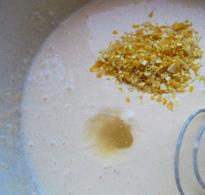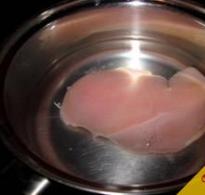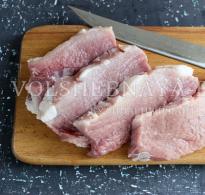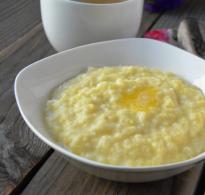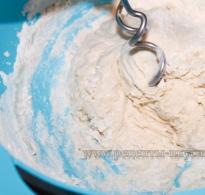Soviet products - the history of doctor's sausage. The composition of the sausage: what is the traditional product made of
In the territory where the Soviet Union once existed, they were very fond of doctor's sausage (and now they eat it with pleasure). She was appreciated in the Baltic States, and in Kazakhstan, and in the poor post-war years, and in the prosperous seventies. But few consumers knew why the sausage is called "Doctor's". Everyone is accustomed to this name of the product, although for some reason it shocked foreigners. If “Language” or “Chicken” sausages were made from offal and poultry meat, then one could only guess what was included in the “Doctor's” and “Children's”. The meaning of these names has been forgotten over time. And let's remember the history of the doctor's sausage. To do this, we have to go back to the thirties of the last century.
The more nutritious, the healthier
The village physician often dealt with patients whose ailment was rooted in poor nutrition. After all, the peasants ate meat only on holidays, and their daily diet consisted of cereals and lean cabbage soup. To cure anemia and similar ailments, the doctor ordered the patient to eat more fatty meat. Maybe this is the secret of why doctor's sausage is called "doctor's"? On a doctor's prescription? Partly yes. Doctor's sausage is very nutritious. And, indeed, doctors believed that it was good to eat it with anemia or after a long fast. But doctor's sausage can hardly be called fatty. It is truly dietary. And it wasn't just some doctor who came up with it. The composition of the sausage was approved by the People's Commissariat of Health. Why did the Country of Soviets so need a special "medical" prescription?

Where did the name "doctor's sausage" come from?
The thirties of the last century… The NEP policy was cancelled. Collectivization, coupled with the seizure of crops from the peasants, led to famine. Huge masses of the population experienced a lack of food. Prolonged starvation led to outbreaks of various diseases. Around the same time, the politician Anastas Ivanovich Mikoyan visited the United States in 1930. During his visit, he also visited Chicago, where he got a firsthand look at how the American meat industry works. Returning to the USSR, Mikoyan, based on the experience gained, created the First Moscow Sausage Factory. This factory was later named after its creator. VNII nutritionists have developed and submitted for approval to the People's Commissariat of Health a recipe for a new sausage product. It, as stated in the documents, was intended specifically for "healing nutrition of the sick, whose health was undermined by the Civil War and tsarist despotism." It is not difficult now to guess why the doctor's sausage got such a name. Even according to the documents, she was a medicine prescribed by a doctor.

Doctor's sausage according to GOST
The government, of course, was disingenuous about the reasons for the mass starvation of the population. But a medicine that quickly restores strength was nevertheless found. The doctor's prescription was verified to the smallest detail. To prepare one hundred kilograms of doctor's sausage, it was necessary to take 25 kg of trimmed beef meat (high-grade pulp, without connective tissues), 70 kg of pork (also first-class quality, lean, without lard), two liters of whole cow's milk and seventy-five chicken eggs. But from the spices it was allowed to add only salt, sugar, a little cardamom and nutmeg. Why is doctor's sausage called "doctor's"? Yes, because it was prescribed for patients with stomach ulcers, colitis and other ailments of the gastrointestinal tract. This nutritious product was really dietary. He could rightfully be included in the diet of children. By the way, at the Moscow plant named after Mikoyan, where in 1936 the first stick "Doctorskoy" rolled off the assembly line, other equally popular brands of sausages were invented: "Amateur", "Braunschweig", "Tea".

Gradual surrender of positions
The recipe for the meat product was approved by GOST, which was strictly adhered to until the seventy-fourth year. Why was it necessary to change the recipe during the "general prosperity"? When the country moved from building a bright future to a stage, it suddenly became clear that the number of livestock is not as large as we would like. In addition, they began to feed the pigs with the waste of the fishing industry, which is why the meat of animals acquired an unpleasant odor. Already GOST 1974 allows the use of starch and flour in the preparation of doctor's sausage. But this was only the beginning of the fall of the once high standard of quality. GOST 23670-79 allowed the use of melange, milk powder and pork skins instead of eggs. Soon, flavor enhancers and antioxidants came into play. The loaf was wrapped in cellophane. That is why gourmets began to ask in bewilderment: “And why is doctor’s sausage called “doctor’s”?”

GOST and TU
In the early 2000s, a myriad of businesses emerged exploiting the popularity of the brand. They cooked their sausage in such a way that it was impossible to call it a dietary product. The current State Standard (2011) allows the use of flour, starch, sodium nitrite in the preparation of the product, and dry substitutes instead of natural eggs and milk. But there are manufacturers who offer the TU product. This abbreviation stands for "Specifications". They have nothing to do with GOST and are developed by the enterprise itself. And it is no longer known why doctor's sausage is called that - after all, it contains smoke flavor, antioxidants E 300-306, addictive monosodium glutamate, stabilizers and acidity regulators. It is unlikely that such a dubious cocktail of all kinds of E-additives can be considered a dietary product.
Why sausage is called "doctor's"
We have already told the origin of the name of this product. The question should be put differently: does it have the right to continue to be considered "medical" food? Folk art has already begun to make up jokes about its dubious quality. For example, in one of them, very indicative, the answer to the question of why the doctor's sausage is called "doctor's" is given: because after eating it, you need to urgently consult a doctor.
We all have certainly heard about the "Doctor's" sausage, but not many people know the history of this famous product.
The history of "Doctor's" sausage is a reflection of almost the entire Soviet history
The 1930s of the twentieth century were both difficult and joyful for the USSR at the same time. The fratricidal Civil War is over, the national economy is being restored. Almost throughout the entire territory of the country, the unification of individual peasant farms into collective farms has been completed, the kulaks have been liquidated as a class. Great construction projects are underway, a powerful industry is being created, which in a decade will allow the country to win the Great War ...
Despite all the great plans, there is not enough meat in the country - the previous difficult years are affecting. And the health of the population must be restored and maintained - the builders of communism must be strong and healthy. Therefore, the idea arises to create a product with a high protein content that could replace meat.
A special role in the creation and development of the food industry in the USSR and in the history of the "Doctor's" sausage will be played by Anastas Ivanovich Mikoyan, since 1934 the People's Commissar of the Food Industry of the USSR. It was he who had to create the country's food industry from scratch. Mikoyan chose the United States as a model, where this industry was already quite well developed. Thanks to the borrowing of "industrial" American food, several varieties of sausages and sausages, industrially processed milk, various canned food, ice cream appeared on the tables of Soviet citizens ...
Under the close personal control of Mikoyan, the construction of several large food industry enterprises began in the USSR - for the manufacture of milk, sausages, and canned food.
April 29, 1936 A.I. Mikoyan signed a decree on the start of the production of several varieties of sausages, a special place among which was occupied by a sausage designed to "improve the health of people who had poor health as a result of the Civil War and suffered from the arbitrariness of the tsarist regime." It was assumed that this type of sausage would be intended for those treated in sanatoriums and hospitals.
The recipe for "Doctor's" sausage from the times of the USSR

The formulation of this product was developed by the best specialists of the country, doctors, employees of the All-Russian Research Institute of the Meat Industry. According to the recipe (GOST 23670-79), 100 kg of sausage should contain 25 kg of premium beef, 70 kg of semi-fat pork, 3 kg of eggs or melange and 2 kg of cow's milk powder whole or skimmed for 100 kg of sausage. Minced meat for sausage was made from fresh meat and had to go through a double cutting. As seasonings, a minimum of table salt was used; granulated sugar or glucose; ground nutmeg or cardamom, spicy seasonings were excluded.
There is a legend that initially they wanted to give the name “Stalinskaya” to this sausage. However, the authors of the recipe quickly realized that the combination "Stalin's sausage" could be misunderstood by the all-powerful NKVD and came up with a name that remained in history and well reflected the quality and purpose of this product.
Until the 1950s, the recipe and quality of the sausage was unchanged according to the standard. Of course, the sausages produced by different meat processing plants varied. It also depended on the quality of the raw materials supplied to the plant and on the experience of the employees. The sausage of the Mikoyanovsky Meat Processing Plant became an ideal and a model - the metropolitan giant, which supplied the nomenclature in the first place, purchased the most expensive and high-quality raw materials. At the same time, sausage was by no means an integral part of the special ration of representatives of the party and state elite - it could be bought in almost any grocery store.
Interesting, but the cost of "Doctor's" was significantly higher than its retail price. In the shops "Doctor" was sold at 2 rubles 20 kopecks. With this money in the mid-70s, you could buy, for example, 220 boxes of matches, 11 ice creams in a waffle cup, 10 packs of Belomorkanal cigarettes, i.e. the price of this sausage was quite acceptable for ordinary citizens.

Changes in the quality of sausages began only in the 70s and this was due primarily to the difficulties that the continuously reformed agriculture began to experience and, of course, to the drought and crop failure in the early 70s. It was at this time that it was allowed to add up to 2% starch or flour to minced meat.
Cardinal changes in the fate of sausages - like all countries - will begin in the mid-80s. The composition of the feedstock will change, in 1997 a new GOST will appear, in accordance with which the name “doctoral” will turn into a brand.
But still, most of us, coming to the meat department of a supermarket and choosing a sausage, will first of all pay attention to the name "Doctor's" ....
I always take only "Doctor's" in the store. I do not like anything else, and even more so something with lard. Smoked once a year is possible, ham is so-so rare, but "Doctor's" is super.
But the history of the "Doctor's" sausage is a reflection of almost the entire Soviet history with its breaks and complexities.
Look here...
The 1930s of the twentieth century were both difficult and joyful for the USSR at the same time. The fratricidal Civil War is over, the national economy is being restored. Almost throughout the entire territory of the country, the unification of individual peasant farms into collective farms has been completed, the kulaks have been liquidated as a class. Great construction projects are underway, a powerful industry is being created, which in a decade will allow the country to win the Great War ...
Despite all the great plans, there is not enough meat in the country - the previous difficult years are affecting. And the health of the population must be restored and maintained - the builders of communism must be strong and healthy. Therefore, the idea arises to create a product with a high protein content that could replace meat. A special role in the creation and development of the food industry in the USSR and in the history of the "Doctor's" sausage will be played by Anastas Ivanovich Mikoyan, since 1934 People's Commissar of the Food Industry of the USSR. It was he who had to create the country's food industry from scratch. Mikoyan chose the United States as a model, where this industry was already quite well developed. Thanks to the borrowing of "industrial" American food, several varieties of sausages and sausages, industrially processed milk, various canned food, ice cream appeared on the tables of Soviet citizens ...
Under the close personal control of Mikoyan, the construction of several large food industry enterprises began in the USSR - for the manufacture of milk, sausages, and canned food.
April 29, 1936 A.I. Mikoyan signed a decree on the start of the production of several varieties of sausages, a special place among which was occupied by a sausage designed to "improve the health of people who had poor health as a result of the Civil War and suffered from the arbitrariness of the tsarist regime." It was assumed that this type of sausage would be intended for those treated in sanatoriums and hospitals.
The formulation of this product was developed by the best specialists of the country, doctors, employees of the All-Russian Research Institute of the Meat Industry. According to the recipe (GOST 23670-79), 100 kg of sausage should contain 25 kg of premium beef, 70 kg of semi-fat pork, 3 kg of eggs or melange and 2 kg of cow's milk powder whole or skimmed for 100 kg of sausage. Minced meat for sausage was made from fresh meat and had to go through a double cutting. As seasonings, a minimum of table salt was used; granulated sugar or glucose; ground nutmeg or cardamom, spicy seasonings were excluded.
There is a legend that initially they wanted to give the name “Stalinskaya” to this sausage. However, the authors of the recipe quickly realized that the combination "Stalin's sausage" could be misunderstood by the all-powerful NKVD and came up with a name that remained in history and well reflected the quality and purpose of this product.
Until the 1950s, the recipe and quality of the sausage was unchanged according to the standard. Of course, the sausages produced by different meat processing plants varied. It also depended on the quality of the raw materials supplied to the plant and on the experience of the employees. The sausage of the Mikoyanovsky Meat Processing Plant became an ideal and a model - the metropolitan giant, which supplied the nomenclature in the first place, purchased the most expensive and high-quality raw materials. At the same time, sausage was by no means an integral part of the special ration of representatives of the party and state elite - it could be bought in almost any grocery store.
Interestingly, the cost of "Doctor's" was significantly higher than its retail price. In the shops "Doctor" was sold at 2 rubles 20 kopecks. With this money in the mid-70s, you could buy, for example, 220 boxes of matches, 11 ice creams in a waffle cup, 10 packs of Belomorkanal cigarettes, i.e. the price of this sausage was quite acceptable for ordinary citizens.
Changes in the quality of sausages began only in the 70s and this was due primarily to the difficulties that the continuously reformed agriculture began to experience and, of course, to the drought and crop failure in the early 70s. It was at this time that it was allowed to add up to 2% starch or flour to minced meat.
Cardinal changes in the fate of sausages - like all countries - will begin in the mid-80s. The composition of the feedstock will change, in 1997 a new GOST will appear, in accordance with which the name “doctoral” will turn into a brand.

There is such an addition. Here's a phrase: According to the recipe (GOST 23670-79), 100 kg of sausage should have contained 25 kg of premium beef, 70 kg of semi-fat pork, 3 kg of eggs or melange and 2 kg of dry whole cow's milk per 100 kg of sausage. or low fat"
This is all fine, but there is another point in this GOST:
2.6. It is allowed to use in the production of boiled sausages, sausages, sausages and meat loaves:
food phosphates in the amount of 0.3% by weight of raw materials (in terms of anhydrous);
- sodium ascorbate or ascorbic acid in the amount of 50 g per 100 kg of raw materials;
Smoke preparations approved by the USSR Ministry of Health;
Pasteurized cow's milk with a mass fraction of fat of 2.5 and 3.2% in the amount of 8 kg instead of 1 kg of whole milk powder with a decrease in the mass of added moisture by 7 kg;
Cow pasteurized non-fat milk in the amount of 11.5 kg instead of 1 kg of skimmed milk powder with a decrease in the mass of added moisture by 10.5 kg;
Powdered cream with a fat content of 42% in the amount of 1 kg instead of 2.1 kg of cream from cow's milk with 20% fat content;
Whole cow's milk powder with a fat content of 25% in the amount of 1 kg instead of 610 g of dry cream with a fat content of 42% or 1281 g of cream from cow's milk with 20% fat content;
egg powder in the amount of 274 g instead of 1 kg of melange or 1 kg (24 pcs.) of chicken eggs;
Trimmed buffalo meat, yak meat instead of trimmed beef meat of the corresponding grade in the production of premium grade sausages up to 50%, first and second grades up to 100%;
Boiled sausages, sausages, sausages and meat loaves of the highest and first grade with manufacturing defects (scrap, deformed loaves, with minced meat over the shell, broth-fat edema, etc.) for the production of boiled sausages, sausages, sausages and meat loaves of the first grade; second grade - for the production of sausages and meat loaves of the second grade in an amount of up to 3% by weight of raw materials in excess of the recipe;
Hemoglobin preparation or food blood in the amount of 0.5-1% by weight of the raw material;
Extracts of spices and garlic instead of natural ones;
Trim beef trimmed in an amount of up to 10% - for beef sausages and sausages of the first grade and up to 30% - for tea sausage, tea meat bread to the mass of trimmed beef of the second grade provided for in the recipes, instead of its corresponding amount;
Trimming meat trimmed pork in an amount of up to 10% - for boiled sausages, meat loaves, sausages of the first grade and up to 20% - for boiled sausages, meat loaves of the second grade to the mass of trimmed bold pork, provided for in the recipes, instead of its corresponding amount. It is not allowed to use beef trimmed beef trimmings and trimmed pork trimmed meat trimmed together;
Protein stabilizer to the mass of raw materials in an amount of up to 5% - for boiled sausages, sausages and meat loaves of the first grade and up to 6% - for boiled sausages and meat loaves of the second grade;
The mass of meat beef, pork and mutton to the mass of raw materials in an amount of up to 5% - for boiled sausages, sausages and meat loaves of the first grade and up to 6% - for boiled sausages and meat loaves of the second grade. For separate mutton sausage - up to 15% of the mass of meat from lean mutton instead of single-grade trimmed mutton;
A mass of meat beef, pork or mutton, obtained by processing bones in saline solutions, in the amount of 4 kg instead of 1 kg of meat mass obtained by mechanical pressing, with a decrease in the mass of added water by 3 kg;
Food plasma (serum) of the blood of slaughtered animals to the mass of raw materials in the following quantities:
up to 5% instead of added water in the production of boiled sausages, frankfurters, sausages and meat loaves of the highest grade;
up to 15% in return for added water in the production of boiled sausages, frankfurters, sausages and meat loaves of the first and second grade;
up to 10% instead of 2% trimmed pork meat and 8% water or 3% trimmed beef (or lamb) meat and 7% water
or up to 15% instead of 3% trimmed pork and 12% water or 4% trimmed beef (or mutton) and 11% water;
Cuts obtained from cleaning boiled smoked meats instead of raw beef or pork fat in an amount of up to 10% in the production of beef sausages, beef sausages, beef meat bread;
Pasteurized non-fat cow's milk instead of added water in an amount 5% higher than the recommended rate of water, except for doctor's, dairy, sorbitol, ordinary sausages, dairy sausages;
0Our reality is that the quality of sausages sold in stores suffers greatly. But if you care about your health, have the desire and free time, then you can cook sausage at home. For example, doctor's sausage, so beloved by everyone, is very easy to prepare at home. And most importantly, you can even feed your children with it. Since there are many recipes for doctor's sausage, we will focus primarily on the option of preparing it according to GOST.
The composition of doctor's sausage according to GOST
So, to prepare such a dish, you will need the following ingredients:
- beef pulp - 250 g;
- bold pork pulp - 700 g;
- natural milk - 200 g;
- one egg;
- sugar - 3 g;
- salt - 2 g;
- ground cardamom - 0.5 g.
Minced meat preparation
Beef and pork meat must be passed through a meat grinder twice. The first time with a large mesh, the second with a small one. Add spices (cardamom, sugar, salt) to minced meat. Mix everything thoroughly.

Next, add the egg with milk. Minced beat with a blender. The result is a viscous mass. Most importantly, don't worry about the color of the sausage. After all, you get a natural color (without dyes). We put the prepared mass in the refrigerator and keep it there for about an hour. If you want the homemade doctor's sausage to have a pink color, then you can add high quality vodka or cognac to the minced meat (2 tablespoons).
Preparation of sausage casings
Doctor's sausage requires careful preparation of the casing. At home, you can use both artificial and natural. It must be cut into segments of 25-30 cm. After that, the shells should be washed with warm, slightly salted water and, on one side, tie their ends with cotton twine, departing from the edge of 2 cm.
An easier option is to use a 30 cm wide baking sleeve.
Sausage stuffing
We fill our shells with minced meat. You can use a special device for this (for example, a meat grinder with the necessary nozzle) for stuffing sausages. Then we form sausages, tightly pressing the shell with our hands.

After that, on the other hand, we tie the shell tightly. In conclusion, you need to carefully examine each sausage and, if large air bubbles are found, gently pierce them with a thin needle.
Sausage cooking
In a saucepan, it is necessary to heat the water to 95 degrees and place the workpieces in it. Doctor's sausage at home is cooked at a temperature of 85-87 degrees for 50 minutes. The main thing to remember is that the water should never boil.
Final stage
At this stage, after cooking, the doctor's sausage is cooled immediately under running water (it will be enough to allocate just a few seconds for this process). Next, the sausage is cooled at room temperature, and then in the refrigerator.

The storage conditions for such a doctor's sausage are quite simple: the temperature should be 4-8 degrees, and as for the period, it must be consumed within 72 hours.
Homemade doctor's sausage, recipe No. 2
Since sausage can be cooked not only according to GOST, we suggest that you familiarize yourself with the recipe, which requires the use of minced pork. It may be similar to "Amateur" or "Doctor's", but the chopping of bacon affects this quality. For example, to get the “Amateur” sausage, not twisted, but cut into pieces bacon is added to the minced meat.
The composition of doctor's sausage according to recipe No. 2 will be as follows:

The list of ingredients has been clarified, now you can proceed directly to the cooking process. So, first we prepare the stuffing. We thoroughly wash the meat, cut off all the films, veins and cut into pieces. Grind the pork with a blender along with garlic and onions to make a creamy mass. Another option for chopping meat is to use a meat grinder. And if you want to get a ham doctor's sausage, then you can add larger pieces of pork (chicken) to the minced meat.
Then add the egg, mix well. Pour spices: black pepper, semolina, nutmeg, salt, gelatin and sunflower oil. And again, mix everything to evenly distribute the added ingredients.
If there is no special form for ham, then we use a baking sleeve. Or there is another original way - to use a box of juice or milk as a form. After all, homemade sausage can be cooked without a special device.
We put the minced meat in a bag (sleeve), roll it up and tighten it in several places with a rope (string), so that the sausage becomes constricted.
You need to cook it for 2 hours after boiling over low heat. The water should boil slightly. And you need such an amount of water that the bag with minced meat is completely covered.
Consider another option for making homemade sausage according to this recipe. It can be cooked in a slow cooker. To do this, in the evening we put a bag of minced meat in a slow cooker. Turn on the "Stew" or "Soup" mode. Set the time to 1 hour. And until the morning the pan will work in heating mode. Most importantly, before cooking, the minced meat in the sleeve must be poured with boiling water. And in the morning we take out the finished sausage from the multicooker and cool it. When it has cooled to room temperature, it should be placed in the refrigerator for five hours (and even better all night). After that, you can treat the household with a delicious doctor's sausage.

If you want the doctor's boiled sausage to be a pleasant pink color, then you can add a natural dye to it, which is the juice of raw beets, and alcohol (cognac, alcohol, vodka), or rather a few spoons of it, will fix this effect.
Other cooking options
According to recipe No. 2, doctor's sausage can be prepared by baking in the oven. The only thing is that the sleeve with minced meat needs to be additionally wrapped with special foil. First, we keep the sausage in the oven for 15 minutes at a temperature of 180 degrees, then lower it to 150 degrees and bake in foil for 30 minutes, after which we remove the foil and bake for another 10 minutes. But before the last 10 minutes, pour some water into the mold.
We would like to note that no matter how you cook boiled sausage at home, it will be much tastier than store-bought, and most importantly, it will be much healthier for you and your entire family. Therefore, you should not spare either time or effort to preserve the health of your loved ones. After all, you can't buy it for any amount of money.
Doctor's sausage prepared according to GOST is a very high-quality and healthy product, the main ingredients of which are meat and spices.
But nowadays, most manufacturers are trying to reduce the production costs of natural ingredients, while reducing quality.
From this, in the products previously respected and loved by the people, all sorts of not too tasty and healthy additives appear.
We invite you to return to the good old traditions and cook real Doctor's sausage with your own hands.
History of Doktorskaya sausage
According to legend, the order to create the "Doctor's" sausage came from Stalin himself.
In addition, the People's Commissariat of Health, with which the recipe was coordinated, is most directly related to doctor's sausage.
According to the people's commissar's verdict, the new product was intended for "sick people who undermined their health as a result of the Civil War and tsarist despotism."
The first loaf of "Doctor's" sausage rolled off the assembly line of the Moscow Meat Processing Plant in 1936.
It is claimed that Doctor's sausage contains all the vitamins and minerals necessary for a healthy and fulfilling life.
The recipe for “improving the health of persons affected by the arbitrariness of the tsarist regime” was verified by Moscow doctors to the smallest detail: 100 kg of sausage contained 25 kg of premium beef, 70 kg of bold pork, 3 kg of eggs and 2 kg of cow's milk. Basically, just what the doctor ordered.
So, by the way, her name appeared. Then hardly anyone could have imagined that the doctor's sausage would have such a long and significant life.
This product has become a real gastronomic hit for more than one generation of citizens; it was accepted at the table both in the Kremlin and in families with the most modest incomes.
Everyone respected the doctoral dissertation, regardless of social status. She was known as a symbol of well-being in the years of total scarcity.
And its cost has become one of the standards for comparative analysis: economists are very fond of measuring the amount of salaries for clarity by the amount of doctoral sausage that can be bought with it.
Food workers explain this consumer triumph by the high content of high-quality fresh meat.
However, in the years of developed socialism, the reputation of a favorite product was dealt a lot of blows.
It all started with an innovative proposal to include fish in the diet of pigs, which was noticeably reflected in the smell of sausage.
Imported frozen beef, the supply of which became massive in the period of early capitalism, did not improve its palatability. And yet the famous brand survived all the tests.
Doctor's sausage was obtained from beef (25%), semi-fat pork (70%), eggs and milk powder (5%).
The complete absence of bacon determined the uniform, light pink color of minced meat on the cut. It had a delicate taste and smell of cardamom.
Doctor's sausage recipe according to GOST industrial
Ingredients according to GOST 23670-79, unsalted raw materials (per 100 kg):
- trimmed beef of the highest grade - 25 kg
- trimmed pork fat - 70 kg
- chicken eggs or egg melange - 3 kg
- cow's milk powder whole or skimmed - 2 kg
- edible salt - 2.090 kg
- sodium nitrite - 7.1 g
- granulated sugar or glucose - 200 g
- ground nutmeg or cardamom - 50 g
- water/ice: 20-25 kg (about 50/50 ratio)
Preparation of Doctor's sausage according to GOST:
1. Place a 3 mm grate on the top and pass the pork and beef through it separately.
2. Place well-sharpened chord blades on the cutter. Load first the whole beef, 1/2 ice water, sodium nitrite, salt and spices, egg. Grind under vacuum (if available on the cutter) until a homogeneous emulsion is obtained. Cutting time is 5-7 minutes, the temperature at the end of the process is not higher than 8 degrees.
2. Without stopping the cutter bowl, load the pork, milk and remaining water with ice, turn on the vacuum and at high speeds of the knives and bowl, chop until cooked - until smooth. Cuttering stops at minced meat temperature of 12 degrees. Take out the prepared stuffing.
The amount of water depends on the type of shell. If it is a barrier plastic - then 20 liters, natural intestines (bruises, blisters, circles) - then 25-30 liters can be.
3. Transfer the minced meat to, shape the loaves and leave them on the draft in a room with a temperature of approximately 6 degrees to hang on the frame for 30-60 minutes.
The standard diameter of a doctor's loaf is 10-15 cm. But there are also Mortadella giants with a diameter of half a meter and a weight of several hundred kg.
4. If you have a plastic shell, then drying is carried out in the heat chamber (no humidity is set, the temperature in the chamber is 55-60 degrees, the time is 30-40 minutes) and cooking at 78-80 degrees to a temperature in the center of the loaf of 72 degrees.
5. Cooling - showering with cold water (can be immersed in a vat) for at least 40 minutes.
Doctor's sausage according to GOST at home
1. Grind pork and beef separately in a meat grinder with 3 mm grate holes.
2. Salt and add sugar according to the recipe above, knead and put in separate containers in the refrigerator for 6-12 hours to ripen the minced meat.
3. Mix both types of minced meat and pass through a meat grinder with holes in the 3 mm grate at least 4-5 times with the addition of finely crushed ice. If you have a blender, you can further grind to a puree state.
4. Fill, if there are factory-made sausage casings, with the resulting minced meat, patting lightly in the process of forming a loaf of sausage and tamping to force out air voids and compact the consistency.
Thin pork or beef intestines are not suitable for Doktorskaya type sausages. It is better to fill with minced meat a cleaned pork stomach or intestines of large diameter, the so-called bungs.
5. Round the edges of the sausage loaf and tie tightly with at least a double knot. Use a small pin to poke holes in the escaping steam during heat treatment.
6. Boil the finished sausage loaves in a saucepan over low heat without boiling at a water temperature of no more than 80-85 degrees, otherwise it will burst, 2-3 hours. The temperature inside the sausage in the center should reach at least 70 degrees C.
It is better to steam with less loss of juice and nutrients.
7. Cool the finished sausage under running cold water at a temperature of at least 10 ° C or put in a container with ice.

